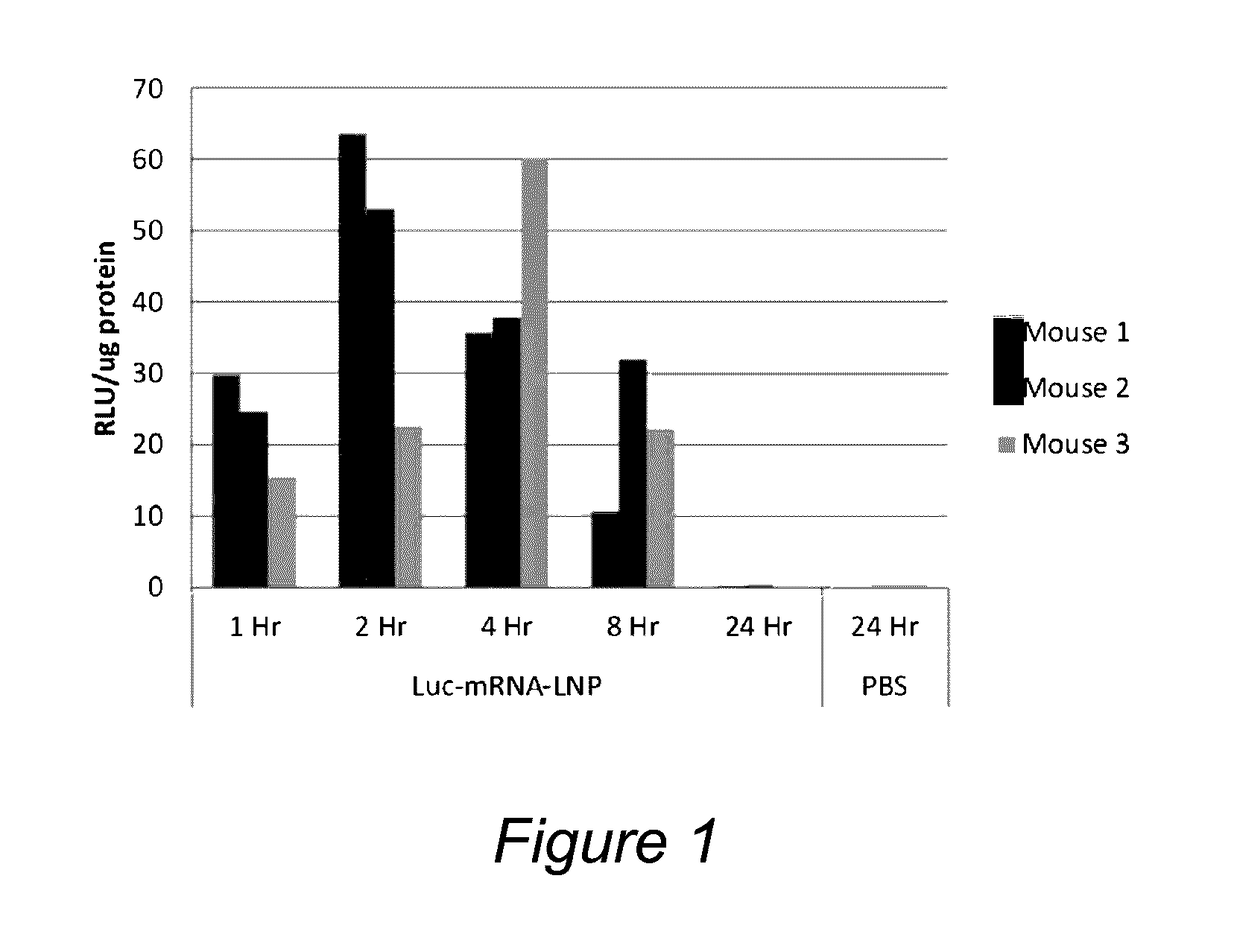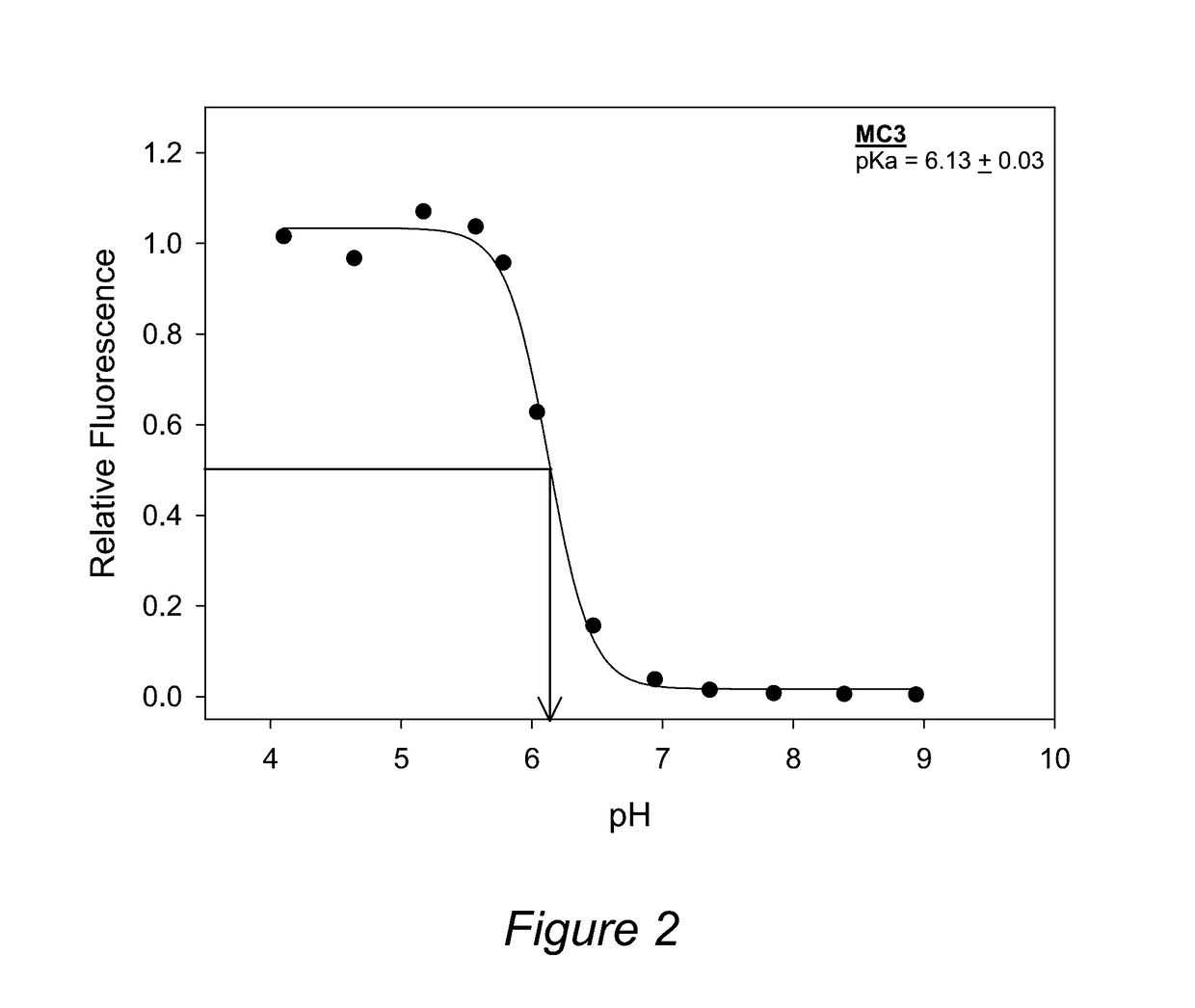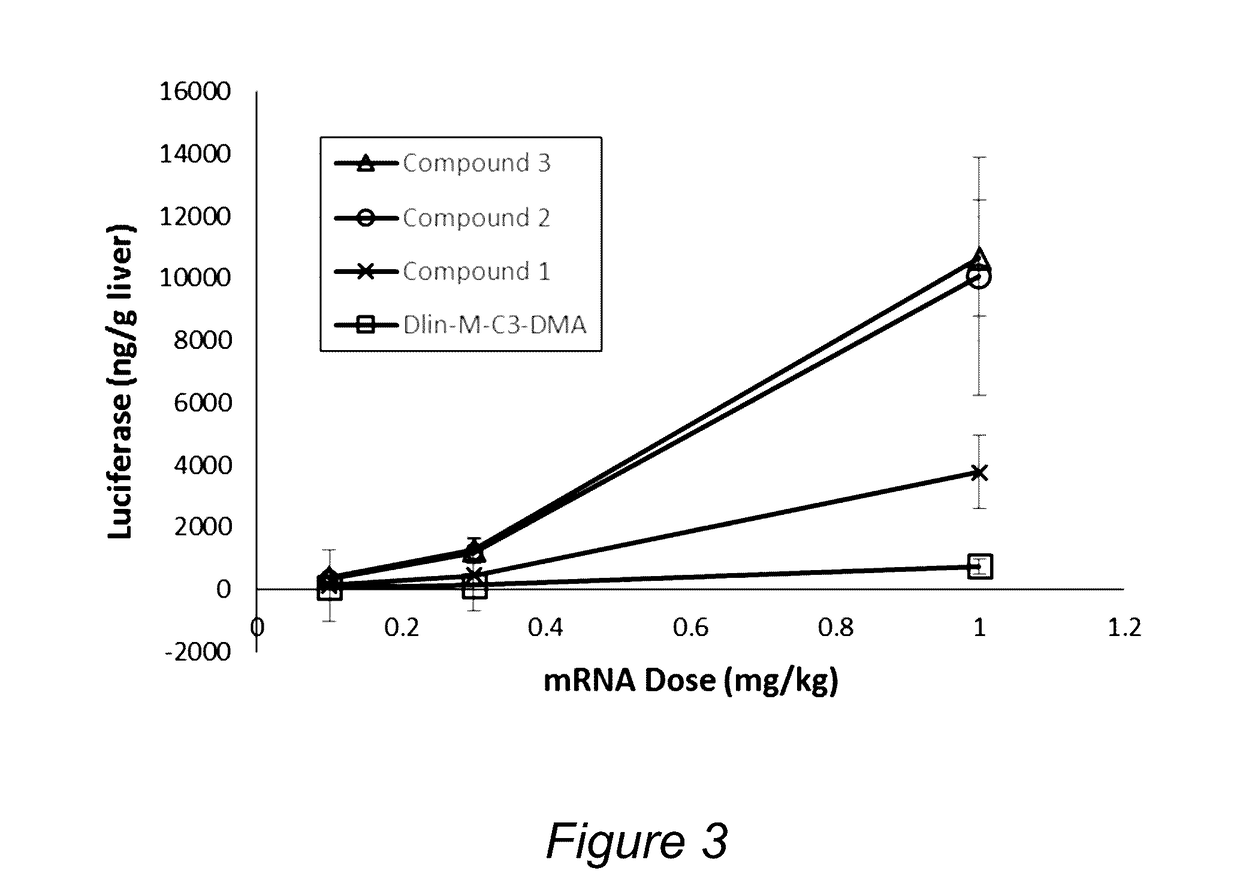Novel lipids and lipid nanoparticle formulations for delivery of nucleic acids
a technology of lipid nanoparticles and nucleic acids, applied in the field of new cationic lipids, can solve the problems of limited ability of free rnas to gain access to the intracellular compartment, and is susceptible to nuclease digestion in plasma
- Summary
- Abstract
- Description
- Claims
- Application Information
AI Technical Summary
Benefits of technology
Problems solved by technology
Method used
Image
Examples
example 1
Luciferase mRNA In Vivo Evaluation Using the Lipid Nanoparticle Compositions
[0157]Cationic lipid, DSPC, cholesterol and PEG-lipid were solubilized in ethanol at a molar ratio of 50:10:38.5:1.5 or 47.5:10:40.8:1.7. Lipid nanoparticles (LNP) were prepared at a total lipid to mRNA weight ratio of approximately 10:1 to 30:1. Briefly, the mRNA was diluted to 0.2 mg / mL in 10 to 50 mM citrate buffer, pH 4. Syringe pumps were used to mix the ethanolic lipid solution with the mRNA aqueous solution at a ratio of about 1:5 to 1:3 (vol / vol) with total flow rates above 15 ml / min. The ethanol was then removed and the external buffer replaced with PBS by dialysis. Finally, the lipid nanoparticles were filtered through a 0.2 μm pore sterile filter. Lipid nanoparticle particle size was approximately 55-95 nm diameter, and in some instances approximately 70-90 nm diameter as determined by quasi-elastic light scattering using a Malvern Zetasizer Nano ZS (Malvern, UK).
[0158]Studies were performed in 6-...
example 2
Determination of pKa of Formulated Lipids
[0161]As described elsewhere, the pKa of formulated cationic lipids is correlated with the effectiveness of LNPs for delivery of nucleic acids (see Jayaraman et al, Angewandte Chemie, International Edition (2012), 51(34), 8529-8533; Semple et al, Nature Biotechnology 28, 172-176 (2010)). The preferred range of pKa is ˜5 to ˜7. The pKa of each cationic lipid was determined in lipid nanoparticles using an assay based on fluorescence of 2-(p-toluidino)-6-napthalene sulfonic acid (TNS). Lipid nanoparticles comprising of cationic lipid / DSPC / cholesterol / PEG-lipid (50 / 10 / 38.5 / 1.5 mol %) in PBS at a concentration of 0.4 mM total lipid are prepared using the in-line process as described in Example 1. TNS was prepared as a 100 μM stock solution in distilled water. Vesicles were diluted to 24 μM lipid in 2 mL of buffered solutions containing, 10 mM HEPES, 10 mM MES, 10 mM ammonium acetate, 130 mM NaCl, where the pH ranged from 2.5 to 11. An aliquot of t...
example 3
Determination of Efficacy of Lipid Nanoparticle Formulations Containing Various Cationic Lipids Using an In Vivo Luciferase mRNA Expression Rodent Model
[0162]The cationic lipids shown in Table 2 have previously been tested with nucleic acids. For comparative purposes, these lipids were also used to formulate lipid nanoparticles containing the FLuc mRNA (L-6107) using an in line mixing method, as described in Example 1 and in PCT / US10 / 22614, which is hereby incorporated by reference in its entirety. Lipid nanoparticles were formulated using the following molar ratio: 50% Cationic lipid / 10% distearoylphosphatidylcholine (DSPC) / 38.5% Cholesterol / 1.5% PEG lipid (“PEG-DMG”, i.e., (1-(monomethoxy-polyethyleneglycol)-2,3-dimyristoylglycerol, with an average PEG molecular weight of 2000). Relative activity was determined by measuring luciferase expression in the liver 4 hours following administration via tail vein injection as described in Example 1. The activity was compared at a dose of 0...
PUM
| Property | Measurement | Unit |
|---|---|---|
| mean diameter | aaaaa | aaaaa |
| mean diameter | aaaaa | aaaaa |
| mean diameter | aaaaa | aaaaa |
Abstract
Description
Claims
Application Information
 Login to View More
Login to View More - R&D
- Intellectual Property
- Life Sciences
- Materials
- Tech Scout
- Unparalleled Data Quality
- Higher Quality Content
- 60% Fewer Hallucinations
Browse by: Latest US Patents, China's latest patents, Technical Efficacy Thesaurus, Application Domain, Technology Topic, Popular Technical Reports.
© 2025 PatSnap. All rights reserved.Legal|Privacy policy|Modern Slavery Act Transparency Statement|Sitemap|About US| Contact US: help@patsnap.com



